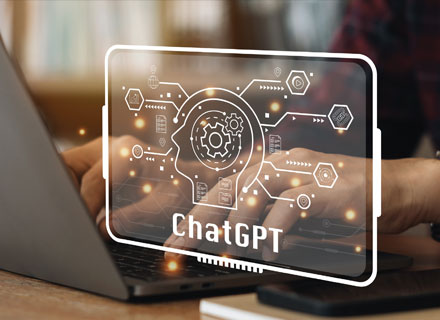OpenAI is in the news again, this time for bringing out its latest large language model (LLM) called GPT-4o. The tech venture, led by Silicon Valley’s latest blue-eyed boy Sam Altman, is touting its latest LLM as their fastest and most powerful AI model so far, something which will make its ChatGPT smarter and easier to use.
Until now, OpenAI’s most advanced LLM was the GPT-4, which was only available to paid users. However, the GPT-4o will be freely available. GPT-4o (O stands for Omni) lets its users put any combination of text, audio, and image and receive responses in the same formats. In this sense, GPT-4o is a true multimodal AI model.
Talking about ChatGPT, the tool, which has been in the news since the 2023 beginning, is leading the way in the generative AI revolution, apart from promising to change the way the global socio-economic order functions.
The AI bot, developed by OpenAI and based on a Large Language Model (or LLM), has continued to grow in terms of its scope and intelligence. The tool is evolving (with GPT-4o being the latest example here).
ChatGPT’s innovation has also resulted in an “AI Arms Race.” While Microsoft, OpenAI’s key backer, has developed Copilot using similar technology, Google has launched its own Google Gemini app. The search engine giant has also introduced its new multimodal AI agent called Project Astra, which is capable of answering users’ queries in real-time via text, audio or video inputs. Also, we have Chinese tech giant Baidu, whose ChatGPT-like Ernie bot has reportedly exceeded 200 million users.
Defining ChatGPT
Describing ChatGPT, OpenAI states, “We’ve trained a model called ChatGPT which interacts in a conversational way. The dialogue format makes it possible for ChatGPT to answer follow-up questions, admit its mistakes, challenge incorrect premises, and reject inappropriate requests. ChatGPT is a sibling model to InstructGPT, which is trained to follow the instruction in a prompt and provide a detailed response.”
Launched in November 2022, ChatGPT enables users to refine and steer a conversation towards a desired length, format, style, level of detail, and language. The tool is built on OpenAI’s proprietary series of generative pre-trained transformer (GPT) models and has been fine-tuned for conversational applications using a combination of supervised learning and reinforcement learning from human feedback.
ChatGPT’s launch was so successful that by January 2023, the tool had become the then fastest-growing consumer software application in history, gaining over 100 million users and contributing to the growth of OpenAI’s current valuation of $80 billion.
ChatGPT was initially built on a family of Large Language Models (or LLMs), collectively known as GPT-3. OpenAI has upgraded things further through its next-generation GPT-4 models that can understand and generate human-like answers to text prompts. These models have also been trained on huge amounts of data.
“ChatGPT’s most original GPT-3.5 model was trained on 570GB of text data from the internet, which OpenAI says included books, articles, websites, and even social media. Because it’s been trained on hundreds of billions of words, ChatGPT can create responses that make it seem like, in its own words, a friendly and intelligent robot,” said Techradar.
ChatGPT’s abilities are vast, as it can generate essays, articles, and poetry. However, during its initial days, users complained about the chatbot’s responses being “inaccurate, untruthful, and misleading at times”. To everyone’s expectation, OpenAI’s leadership acted honestly on the problem and made further operational corrections to their chatbot.
The ‘chat’ part of the ChatGPT refers to the AI-powered product’s front-end that OpenAI has built for its GPT language model. The second and third words show that this model was created using ‘generative pre-training’, which means it’s been trained on huge amounts of text data to predict the next word in a given sequence.
“Lastly, there’s the ‘transformer’ architecture, the type of neural network ChatGPT is based on. Interestingly, this transformer architecture was actually developed by Google researchers in 2017 and is particularly well-suited to natural language processing tasks, like answering questions or generating text,” Techradar reported further.
ChatGPT is based on a language model from the GPT-3.5 series, whose training by OpenAI was finished in early 2022. A more advanced GPT-4 model is now available to ChatGPT Plus subscribers.
“OpenAI did also previously release earlier GPT models in limited form – its GPT-2 language model, for example, was announced in February 2019, but the company said it wouldn’t release the fully-trained model due to its concerns about malicious applications of the technology,” the tech news website commented.
In 2020, OpenAI released a larger and more capable model, called GPT-3. However, it was the arrival of ChatGPT in November 2022 that made the AI-powered technology burst into the mainstream.
The cost structure
ChatGPT has both free and paid tiers. There was a rumour earlier about OpenAI adding a “ChatGPT Professional Tier,” the venture countered it by stating that it was introducing a “pilot subscription plan” called ChatGPT Plus in the United States. By March 2023, the company made the subscription tier available to everyone.
Reports back then stated that the “Professional Tier” would be always available (no blackout windows), along with fast responses from ChatGPT and also, the users getting the benefit of posting as many messages (human prompts) as they need in a day.
Coming back to the present day, ChatGPT Plus now costs $20 per month (around £16 / AU$30) and brings many benefits over the free tier.
“It promises to give you full access to ChatGPT even during peak times, which is when you’ll otherwise frequently see ChatGPT is at capacity right now messages during down times,” stated Techradar, as it continued, “OpenAI says the ChatGPT Plus subscribers also get faster response times, which means you should get answers around three times quicker than the free version (although this is no slouch). And the final benefit is priority access to new features and improvements, like the experimental ‘Turbo’ mode that boosts response times even further.”
Decoding ChatGPT’s functionality
ChatGPT’s working style is simple: once the user gives the chatbot a question/prompt, it passes through the AI model and then the ChatGPT produces a response based on the information the user has given and how that fits into its vast amount of training data. It’s during this training that ChatGPT has learnt what word, or sequence of words, typically follows the last one in a given context.
ChatGPT’s functionality is based upon a combination of deep learning algorithms, natural language processing, and a good dose of generative pre-training, which all combine to help the tool produce disarmingly human-like responses to text questions.
However, ChatGPT has time and time again been plagued by ‘hallucinations.’ Let’s explain things further. There have been reports about chatbot users experiencing a wild array of confusing and even threatening responses from the AI-powered tool, while some saw ChatGPT getting stuck in a loop of repeating nonsensical text, while others were subjected to invented words and weird monologues in broken Spanish.
ChatGPT’s training was done through a vast amount of text covering a huge range of subjects. The broader usage can be divided into two categories: natural language tasks and coding assistance. For creators, ChatGPT can serve wonders, as the tool can write poetry, and create fictions.
Another thing about the chatbot is that its ability to quickly answer questions, that too in a detailed manner, can make it a worthy challenger to traditional search engines like Google and Bing.
“Where Google responds to queries with pages (and pages) of blue links ranked by search engine optimisation (SEO), ChatGPT’s AI collates information from thousands of sources to provide direct answers in a conversational manner,” Techradar reported about the chatbot’s capability back in December 2022, when ChatGPT just made its public debut.
Among other language-based tasks, ChatGPT can do translations with ease, helping the users learn new languages in the process and generating job descriptions. Talking about ChatGPT’s proficiency in coding-related tasks, the tool’s ability to create code from natural speech makes it a powerful ally for both new and experienced coders who either aren’t familiar with a particular language or want to troubleshoot existing code. One downside here is that the threat actors can use the tool to create malicious emails and malware.
Microsoft has already lined up plans to integrate ChatGPT’s capabilities into Skype, where it’ll be able to produce meeting summaries or make suggestions based on questions that pop up in group chats.
Knowing ChatGPT 4
In March 2023, OpenAI announced that its next-gen language model, GPT-4, was available to developers and ChatGPT Plus subscribers, as Microsoft too confirmed that the new Bing was already running on GPT-4.
“The big change from GPT-3.5 is that OpenAI’s newest language model is multimodal, which means it can process both text and images. This means you can show it images and it will respond to them alongside a text prompt – an early example of this, noted by The New York Times, involved giving GPT-4 a photo of some fridge contents and asking what meals you could make from the ingredients,” explains Techradar.
“Apps running on GPT-4, like ChatGPT, have an improved ability to understand context. The model can, for example, produce language that’s more accurate and relevant to your prompt or query. GPT-4 is also a better multi-tasker than its predecessor, thanks to an increased capacity to perform several tasks simultaneously,” it continued further.
OpenAI has also made safety a big focus of GPT-4, with the start-up working for over six months to put it through a better monitoring framework and alongside experts in a range of specialist fields to make sure its answers are both accurate and sensitive. And yes, the users can even get the chatbot to talk and produce images, with pictures being used as prompts as well.
Another new feature of GPT-4 is the ability for users to create their own custom bots, called GPTs. Talking about GPT-4o, OpenAI CTO Mira Murati said that the updated model is much faster, with improved capabilities across text, vision, and audio formats. The model will be free for all users while paid users will continue to have up to five times the capacity limits of free users.
Altman dubbed the model as “natively multimodal,” which means the latter can generate content or understand commands in voice, text, or images. The AI model will mimic human modulations in its verbal responses and will try to detect people’s moods.

